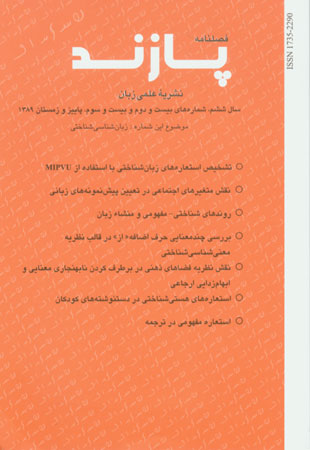فهرست مطالب

فصلنامه پازند
پیاپی 22-23 (پاییز و زمستان 1389)
- 126 صفحه، بهای روی جلد: 20,000ريال
- تاریخ انتشار: 1390/05/05
- تعداد عناوین: 8
-
صفحه 5
-
Page 7Pragglejaz Group presented MIP as the first explicit and systematic procedure for linguistic metaphor identification in 2007, and now MIPVU is the refined and extended version. This paper tries to introduce and examine this method according to data gathered from Persian language.Keywords: Cognitive Semantics, Conceptual Metaphor, MIPVU
-
Page 19In this research, we were looking for the effect of three factors including; social class, geographical difference and sex in determining prototypes. Using field research, we gave one questionnaire including 7 questions to 400 students boys and girls at the fourth grade of elementary schools from both north and south of Tehran; accordingly, the social class was determined. The research findings show that People with different social classes, sexes and geographical environment have different prototypes for each category in their minds and these variables, even in the area of one city, can have noticeable effect on children's categorization of different phenomena. On this basis, the educational system needs to be considerate about these differences represented in text books and basic level vocabularies.Keywords: categorization, prototype, fuzzy theory, family resemblance
-
Page 37Conceptual Prototypes as primes or basic concepts serve as means to form schemas of Linguistic units, thus the hypothesis of the natural- arbitrary – cognitive origin of Language seems propabable. The author believes that there are two clues which help us evaluate about mentioned hypothesis. One is some diachronic data provided by ancient dictionaries and the other is Child Language Acquisition Procedure.Keywords: Conceptual Prototype, basic concepts, cognitive process, language acquisition
-
Page 45The present paper is an attempt to analyze the Persian preposition “az”[from] in cognitive semantics. After the analysis of this preposition according to Tyler and Evans’s model (2003), it is evident that "az" has a semantic network which includes the core sense (prototype) in the center and the other distinct but related senses in the periphery.Keywords: polysemy, prototype, trajectory, landmark, metaphor
-
Surveying the Role of Mental Spaces Theory in Eliminating Semantic Anomaly & Referential AmbiguitiesPage 65This paper is an attempt to explain the concept of mental space and the relationship between mental spaces and metonymy and the role of this theory in eliminating semantic anomaly and referential ambiguities. The space-maker linguistic elements will also be introduced in this paper. The authors, as native speakers of Persian who have a good command of English and German and familiar with French have used their intuitions in gathering data. They have checked the correctness of French data by consulting with other speakers of French. Findings of this survey showed that different moods of the verb, changing predicates and diectics are examples of linguistic elements which serve as space makers whose existence in languages is the representation of mental spaces and this representation in its own turn, is the reflection of the same mental mechanism in human beings in linguistic codification and a proof for considering cognitive universals in linguistic analysis.Keywords: Theory of Mental Spaces, Changing Predicates, Value for the Variables, Mental Scanning, Cognitive Universals
-
Page 79Metaphor in cognitive semantics is the fundamental mechanism of language and thought. By analyzing the representations of metaphor in language, we would discover the most significant processes of mind. Moreover, since it has been always fruitful for cognitive linguists to study acquisition and development of language, the authors of this paper decided to investigate the frequency and variation of conceptual metaphors that children use in their own stories. The reason behind selecting such data as the research corpus was that investigation on ontological metaphors in children’s literature reveals the manifestation and usage of such mechanisms by children. In order to achieve the above mentioned purpose, 60 pieces of scripts (including story, letter, summery, and poem) written by children were selected from Aroosak-e Sokhangoo3, a monthly published magazine in Iran. Once the scripts were studied, the sentences containing conceptual metaphors were elicited and constituted the research corpus. Then the domains based on which the conceptual metaphors had been formed were determined and accordingly the representations were classified. Eventually, the statistics of the conceptual metaphors employed by children have been presented, showing that whether they have a tendency to cognitively use metaphor in their language or not. The outcome of this study provides information about the knowledge extent, high-frequent domains of conceptualization, and traces of emotional and cultural elements represented in the language of children.Keywords: Cognitive linguistics, Cognitive semantics, conceptual metaphor, ontological metaphor, children's writings
-
Page 3The present paper employ a cognitive approach to metaphor launched by Lakoff and Johnson’s influential book, Metaphors We Live By, and adopts the cognitive translation hypothesis proposed by Kovecses (2005). The corpus of the study includes two collections of documentary films entitled Planet Earth and Elegant Universe, altogether nine hundred minutes, translated by Iran Market Center and Mehr & Sepehr Software Co. respectively. The reasons behind choosing these documentaries are first, similarity of genre (i.e. documentary) and second, diversity of the context under study. The study first identified different instances of conceptual metaphors in English and Persian texts. Then it examined similarities and differences of the conceptual mappings based on comparative literature and explored the translation strategies underlying them and illustrated what a cognitive approach could offer to the description of metaphor in translation. The results obtained from the comparison of linguistic and cultural peculiarities of the metaphorical expressions between the two languages revealed that similarities in metaphorical expressions increase translatability, while differences hinder the translation process.Keywords: Cognitive approach, conceptual metaphor, mapping

